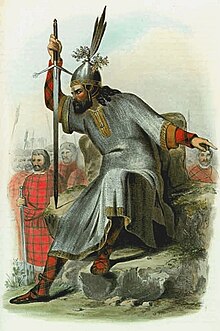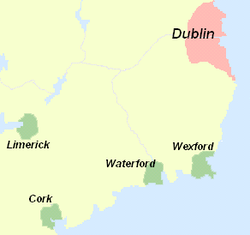Norse–Gaels
The Norse–Gaels (
Over time, the Norse–Gaels became ever more
Name
The meaning of Gall-Goídil is 'Foreign[er] Gaels' and although it can in theory mean any Gael of foreign origin, it was used of Gaels (i.e. Gaelic-speakers) with some kind of Norse identity.[citation needed] This term is subject to a large range of variations depending on chronological and geographical differences in the Gaelic language, e.g. Gall Gaidel, Gall Gaidhel, Gall Gaidheal, Gall Gaedil, Gall Gaedhil, Gall Gaedhel, Gall Goidel, Gall Ghaedheil, etc. The modern term in Irish is Gall-Ghaeil or Gall-Ghaedheil, while the Scottish Gaelic is Gall-Ghàidheil.[1]
The Norse–Gaels often called themselves Ostmen or Austmen, meaning East-men, a name preserved in a corrupted form in the Dublin area known as Oxmantown which comes from Austmanna-tún (homestead of the Eastmen).[citation needed] In contrast, they called Gaels Vestmenn (West-men) (see Vestmannaeyjar and Vestmanna).[citation needed]
Other terms for the Norse–Gaels are Norse-Irish, Hiberno-Norse or Hiberno-Scandinavian for those in Ireland, and Norse-Scots or Scoto-Norse for those in Scotland.
History


The Norse–Gaels originated in
Gaelicised Scandinavians dominated the region of the Irish Sea until the
Ireland
The Norse are first recorded in Ireland in 795 when they sacked Lambay Island. Sporadic raids then continued until 832, after which they began to build fortified settlements throughout the country. Norse raids continued throughout the 10th century, but resistance to them increased. The Norse established independent kingdoms in Dublin, Waterford, Wexford, Cork and Limerick. These kingdoms did not survive the subsequent Norman invasions, but the towns continued to grow and prosper.
The term Ostmen was used between the 12th and 14th centuries by the English in Ireland to refer to Norse–Gaelic people living in Ireland. Meaning literally "the men from the east" (i.e. Scandinavia), the term came from the Old Norse word austr or east. The Ostmen were regarded as a separate group from the English and Irish and were accorded privileges and rights to which the Irish were not entitled. They lived in distinct localities; in Dublin they lived outside the city walls on the north bank of the River Liffey in Ostmentown, a name which survives to this day in corrupted form as Oxmantown. It was once thought that their settlement had been established by Norse–Gaels who had been forced out of Dublin by the English but this is now known not to be the case. Other groups of Ostmen lived in Limerick and Waterford. Many were merchants or lived a partly rural lifestyle, pursuing fishing, craft-working and cattle raising. Their roles in Ireland's economy made them valuable subjects and the English Crown granted them special legal protections. These eventually fell out of use as the Ostmen assimilated into the English settler community throughout the 13th and 14th centuries.[3]
Scotland
The
The Hebrides are to this day known in Scottish Gaelic as Innse Gall, 'the islands of foreigners';[5] the irony of this being that they are one of the last strongholds of Gaelic in Scotland.
The MacLachlan clan name means 'son of the Lakeland' believed to be a name for Norway. It has its Scottish clan home on eastern Loch Fyne under Strathlachlan forest. The name and variations thereof are common from this mid/southern Scottish area to Irish Donegal to the extreme west.
Iceland and the Faroes
It is recorded in the
A number of Icelandic personal names are of Gaelic origin, including
. A number of placenames named after the papar exist on Iceland and the Faroes.According to some circumstantial evidence, Grímur Kamban, seen as the founder of the Norse Faroes, may have been a Norse Gael:[7]
According to the Faereyinga Saga... the first settler in the Faroe Islands was a man named Grímur Kamban – Hann bygdi fyrstr Færeyar, it may have been the land taking of Grímur and his followers that caused the anchorites to leave... the nickname Kamban is probably Gaelic and one interpretation is that the word refers to some physical handicap (the first part of the name originating in the Old Gaelic camb crooked, as in Campbell Caimbeul Crooked-Mouth and Cameron Camshron Crooked Nose), another that it may point to his prowess as a sportsman (presumably of camóige / camaige hurley – where the initial syllable also comes from camb). Probably he came as a young man to the Faroe Islands by way of Viking Ireland, and local tradition has it that he settled at Funningur in Eysturoy.
Mythology
Modern names and words
Even today, many surnames particularly connected with Gaeldom are of Old Norse origin, especially in the Hebrides and Isle of Man. Several Old Norse words also influenced modern Scots English and Scottish Gaelic, such as bairn (child) from the Norse barn (a word still used in Denmark, Norway, Sweden, and Iceland).[citation needed]
Surnames
| Gaelic | Anglicised form | "Son of-" |
|---|---|---|
| Mac Asgaill | MacAskill, McCaskill , Castell, Caistell
|
Áskell |
| Mac Amhlaibh (confused with native Gaelic Mac Amhlaidh, Mac Amhalghaidh) |
Cawley , MacCamley, McCamley, Kewley
|
Óláf |
| Mac Corcadail | McCorquodale, Clan McCorquodale, Corkill, Corkhill, Corkell, McCorkindale, McCorkle, McQuorkell, McOrkil | Þorketill |
| Mac Coitir | Cotter, MacCotter, Cottier | Óttar |
| Mac DubhGhaill, Ó DubhGhaill, | Doyle, McDowell, MacDougal | Dubgall
|
| Mac Ìomhair | MacIver, Clan MacIver, MacIvor, MacGyver, McKeever, etc. | Ívar |
| Mac Raghnall | Crellin, Crennel | Rögnvald |
| Mac Shitrig[13] | MacKitrick, McKittrick | Sigtrygg |
| Mac Leòid | MacLeod | Ljótr[14]
|
Forenames
| Gaelic | Anglicised form | Norse equivalent |
|---|---|---|
Amhlaibh (confused with native Gaelic Amhlaidh, Amhalghaidh) |
Aulay (Olaf) | Ólaf |
| Goraidh | Gorrie (Godfrey, Godfred), Orree (Isle of Man) | Godfrið |
| Ìomhar | Ivor | Ívar (Ingvar) |
Raghnall
|
Ranald (Ronald, Randall, Reginald[15]) | Rögnvald |
| Somhairle | Sorley (or Samuel) | Sumarliði (Somerled) |
| Tormod | Norman | Þormóð |
| Torcuil | Torquil | Torkill, Þorketill |
See also
- Caill Tomair, a sacred grove near Dublin targeted by Brian Boru in the year 1000
- Scandinavian York
- Old English (Ireland)
- Clan Donald
- Earl of Orkney
- Faroe Islanders
- Gallowglasses
- Icelanders
- Kings of Dublin
- List of rulers of the Kingdom of the Isles
- Diocese of Sodor and Man
- Galley
- Lord of the Isles
- Lords of Galloway
- Papar
References
- ^ Clare Downham. Hiberno-Norwegians and Anglo-Danes:anachronistic ethnicities and Viking-Age England. University of Aberdeen.
- ISBN 9780198217312.
The Gallgaedil of 12th-century Galloway appear to have been predominantly Gaelic-speakers...remained a people separate from the Scots...Their separateness seems to have been established not by language but by their links with Man, Dublin, and the Innsi Gall, the Hebrides: they were part of a Hiberno-Norse Irish-Sea world
- ISBN 9781846450297.
- ^ Bannerman, J., The Lordship of the Isles, in Scottish Society in the Fifteenth Century, ed. J. M. Brown, 1977.
- ISBN 1840183764. p. 104
- ^ Scott, Brian M. (2003). "Old Norse Forms of Early Irish Names". Retrieved 22 September 2021.
- ^ Schei, Liv Kjørsvik & Gunnie Moberg (2003) The Faroe Islands. Birlinn.
- ^ a b Zimmer, Heinrich (1891). Keltische Beiträge III, in: Zeitschrift für deutsches Alterthum und deutsche Litteratur (in German). Weidmannsche Buchhandlung. pp. 15ff.
- ^ Scowcroft (1995), p. 154
- ^ Scott, Robert D. (1930), The thumb of knowledge in legends of Finn, Sigurd, and Taliesin, New York: Institute of French Studies
- ^ Matasović, Ranko (2009). "wēnā". Etymological Dictionary of Proto-Celtic. Brill Academic Publishers. p. 412.
- ^ McCone, Kim (2013). "The Celts: questions of nomenclature and identity", in Ireland and its Contacts. University of Lausanne. p.26
- ^ McKittrick Name Meaning and History Retrieved on 23 April 2008
- ^ Mcleod Name Meaning and History Retrieved on 23 April 2008
- ^ the option favoured by early Scottish sources writing in Latin
Bibliography
- Downham, Clare (2009). "Hiberno-Norwegians and Anglo-Danes". Mediaeval Scandinavia. 19. University of Aberdeen. ISSN 0076-5864.
- Haywood, John (1995). The Penguin Historical Atlas of the Vikings. London: Penguin. ISBN 0140513280.
- McDonald, R. Andrew (1997). The Kingdom of the Isles: Scotland's Western Seaboard, c. 1100 – c. 1336. East Linton: Tuckwell Press. ISBN 1898410852.
- Ó Cróinín, Dáibhí (1995). Early Medieval Ireland, 400–1200. London: Longman. ISBN 0582015669.
- Oram, Richard (2000). The Lordship of Galloway. Edinburgh: John Donald. ISBN 0859765415.
- Scholes, Ron (2000). Yorkshire Dales. Ashbourne, Derbyshire: Landmark. ISBN 1901522415.
External links
 Media related to Norse-Gaels at Wikimedia Commons
Media related to Norse-Gaels at Wikimedia Commons- Norse History of Clan Gunn of Scotland


